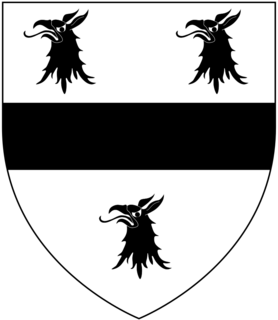
Exeter Cathedral, properly known as the Cathedral Church of Saint Peter in Exeter, is an Anglican cathedral, and the seat of the Bishop of Exeter, in the city of Exeter, Devon, in South West England. The present building was complete by about 1400, and has several notable features, including an early set of misericords, an astronomical clock and the longest uninterrupted medieval stone vaulted ceiling in the world.

The Dean of Christ Church Cathedral, Dublin is the senior official of that church, the cathedral of the United Diocese of Dublin and Glendalough in the Church of Ireland, and head of the Chapter, its governing body. A Dean has presided over Christ Church Cathedral since around 1539, before which the cathedral was a Priory under Augustinian rules, headed by a Prior, back to the time of Archbishop St. Laurence O'Toole. Aspects of the cathedral administration are overseen by the Cathedral Board, which the Dean chairs.

John Hales was Bishop of Coventry and Lichfield (1459-1490). He was one of the Worthies of Devon of the biographer John Prince (d.1723).

The Dean of Exeter is the head of the Chapter of Cathedral Church of Saint Peter in Exeter, England. The chapter was established by William Briwere, Bishop of Exeter (1224–44) who set up the offices of dean and chancellor of Exeter Cathedral, allowing the chapter to elect those officers. The deanery is at 10 The Close, Exeter. The current dean is Jonathan Greener.
Roger de Wynkleigh was Dean of Exeter between 1231 and 1252.
Ivo was the inaugural Dean of Wells between 1140 and 1164.
Richard de Spakeston was the Dean of Wells between 1160 and 1174.
Ralph of Lechlade was the Dean of Wells during 1217.
Peter of Chichester was the Dean of Wells during 1220.
William of Merton was the Dean of Wells during 1237.
William Burnell was the Dean of Wells during 1292.
Nicholas Slake was the Dean of Wells during 1398.
Thomas Tuttebury was the Dean of Wells at the beginning of the fifteenth century. He was also simultaneously Archdeacon of Buckingham.
William Witham was incumbent at St Marylebone until 12 November 1454, when he exchanged the office for that of Archdeacon of Stow. He was then Archdeacon of Leicester, Dean of Arches and Dean of Wells until his death before 1473.
Ralph Barlow was the Dean of Wells between 1621 and 1631.
George Warburton was the Dean of Wells between 1631 and 1641.
Samuel Creswicke was an Anglican priest.
George William Lukin was the Dean of Wells between 1799 and his death on 27 November 1812.

The Devon and Exeter Institution is a subscription library in the City of Exeter, Devon, founded in 1813 for "The general diffusion of science, literature and the arts". It is situated at 7, Cathedral Close, Exeter, in a building facing the north side of Exeter Cathedral which was formerly the Exeter townhouse of the Courtenay family of Powderham Castle.

Exeter Cathedral School (ECS) is a 3–13 mixed, Church of England, independent day and boarding choir and preparatory school in Exeter, Devon, England. It has been closely associated with Exeter Cathedral since it was first recorded as existing in the 12th century.
This page is based on this
Wikipedia article Text is available under the
CC BY-SA 4.0 license; additional terms may apply.
Images, videos and audio are available under their respective licenses.




